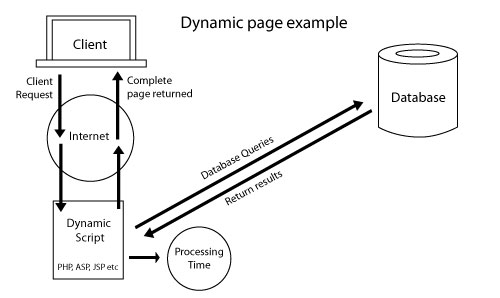
DIY – Basic Cache System

หลักการทำงานทั่วๆไปของ website ปัจจุบัน จะมีลำดับการทำงานแบบนี้ครับ
1. user เข้าหน้า website (user ส่ง request ไปที่ web server)
2. server ประมวลผล
3. server ดึงข้อมูลมาจาก database
4. server ได้รับข้อมูลจาก database แล้วนำมาประมวลผลอีกรอบ
5. server ประมวลผลเสร็จส่งไฟล์กลับไปให้
ซึ่งขั้นตอนทั้ง ก็จะให้ memory ในการทำงาน

แต่เมื่อเราทำระบบ cache file, server ก็จะใช้ memory ในการทำงานน้อยลงมาก
เช่น การ cache HTML ไฟล์จะช่วยลดได้ดังนี้
ข้อ “2” ก็ไม่ต้องแล้ว หา cache file ก็พอ
ข้อ “3” ไม่ต้องไปดึงข้อมูลมาจาก database แล้ว อยู่ใน cache file แล้ว
ข้อ “4” ไม่ต้องแล้ว
ที่เหลือก็ไปดึง cache file ที่ต้องการมาแล้วก็ส่งให้ user
สรุปการทำงานก็จะเป็น
1. user เข้าหน้า website (user ส่ง request ไปที่ web server)
2. server ประมวลผลไปเรียก cache file ที่ต้องการมา
3. server ประมวลผลเสร็จส่งไฟล์กลับไปให้
PHP – Basic Cache System

หลักการทำงานของระบบ cache ในบทความนี้จะเป็นแบบนี้
1. user ส่ง request มา
2. server ตรวจสอบดูว่ามี cache file หรือเปล่า
ถ้ามี cache file ก็จะส่ง cache file นั้นให้เลย ถ้าไม่มีก็
– ดึงข้อมูลที่ต้องการ
– ประมวลผล
– ทำเป็น HTML file
– สร้าง cache file
– เก็บไว้ใน cache folder
– ส่งข้อมูลจาก Output buffer นั้นออกไปให้ user
ตัวอย่าง PHP Code
ตัวอย่างนี้จะเป็น PHP Code – basic cache system โดยวิธีใช้ Output buffer และ filesystem
// Example code
$cache_ext = '.html'; //file extension
$cache_time = 3600; //Cache file expires afere these seconds (1 hour = 3600 sec)
$cache_folder = 'cache/'; //folder to store Cache files
$ignore_pages = array('', '');
$dynamic_url = 'http://'.$_SERVER['HTTP_HOST'] . $_SERVER['REQUEST_URI'] . $_SERVER['QUERY_STRING']; // requested dynamic page (full url)
$cache_file = $cache_folder.md5($dynamic_url).$cache_ext; // construct a cache file
$ignore = (in_array($dynamic_url,$ignore_pages))?true:false; //check if url is in ignore list
if (!$ignore && file_exists($cache_file) && time() - $cache_time < filemtime($cache_file)) { //check Cache exist and it's not expired.
ob_start('ob_gzhandler'); //Turn on output buffering, "ob_gzhandler" for the compressed page with gzip.
readfile($cache_file); //read Cache file
echo '<!-- cached page - '.date('l jS \of F Y h:i:s A', filemtime($cache_file)).', Page : '.$dynamic_url.' -->';
ob_end_flush(); //Flush and turn off output buffering
exit(); //no need to proceed further, exit the flow.
}
//Turn on output buffering with gzip compression.
ob_start('ob_gzhandler');
######## Your Website Content Starts Below #########
// your content file
######## Your Website Content Ends here #########
if (!is_dir($cache_folder)) { //create a new folder if we need to
mkdir($cache_folder);
}
if(!$ignore){
$fp = fopen($cache_file, 'w'); //open file for writing
fwrite($fp, ob_get_contents()); //write contents of the output buffer in Cache file
fclose($fp); //Close file pointer
}
ob_end_flush(); //Flush and turn off output buffering
นอกจากตัวอย่าง code นี้, ผู้เขียนแนะนำ cache ไฟล์แยกเป็นส่วนๆเช่น header, content, footer แทนที่จะเป็นการ cache ทั้งหมดเลยดังตัวอย่างด้านบน